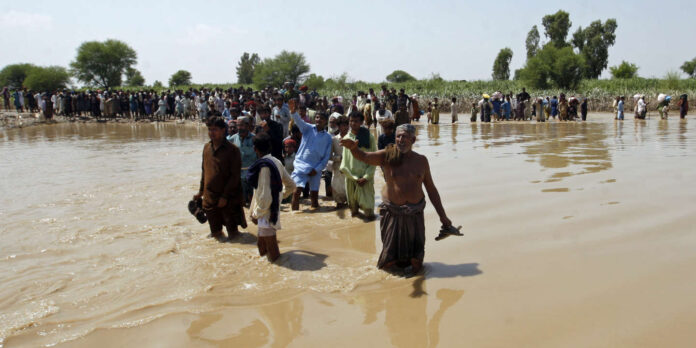It is anticipated that between 25 million to 1 billion people will migrate by 2050 due to climate change. Hence, climate-induced displacement directly impacts urban life because most of the migrants move toward cities to seek a safe and better life. Alone in 2022, 30 million people have been displaced in the world by climate-related disasters. According to Anadolu Agency, a Turkish-based news agency, about 0.7 million people migrate annually from rural to urban areas in Pakistan owing to floods and droughts. Pakistan has experienced large and small natural disasters since its inception. These disasters included floods, earthquakes, windstorms, droughts, and more; these catastrophizes destroyed the infrastructure, lives, livestock, livelihood, health, education, communication, business, qnd suchlike. The 2022 rain-flood has been the worst natural calamity in the history of Pakistan which affected and damaged it more than the Indian Ocean tsunami 2004, the Kashmir earthquake 2005, Haiti earthquake of 2010 and even 2010 flood.
Thus, hundreds of thousands of people have been compelled to live on the roadside since the pouring rain of August in Sindh that hit more than 50 million people. Reuters reported that Sindh has been the most affected province by this ”unprecedented climate change” that received 471 percent of the rain, which has not been observed for 30 years. According to Sherry Rehman, federal Minister of Climate Change, one-third of the country has been submerged through this heavy monsoon rain. The flood has impacted more than two million acres of which Sindh has the highest share of 1.54 million acres. About 3000 km of roads and 145 bridges have either been severely damaged or destroyed. NDMA reported that 80 districts of the country have been declared as ‘calamity-hit’ including 23 districts of Sindh. Approximately, 896,000 houses have been destroyed, 386,039 houses have been under flood water and more than 135,710 households become internally displaced persons (IDPs) in Sindh.
Moreover, 116,65 entirely and more than 0.3 million partially houses have been destroyed. Additionally, the death ratio has also been enhanced up to 1500 and 12,728 have been injured in which southern areas of Sindh have reported 578 deaths and 8,321 injuries. The government has estimated the loss of $30 billion as well as declared a national emergency on 30 August 2022 and appealed to national and international donors for aid.
It has been disclosed that 54 percent of the total urban population of Pakistan lives in ten big cities. However, there are 540 towns excluding big cities existing in Pakistan thus, the remaining population is living in these towns. We must have to facilitate these towns at a large scale in the field of education, health, housing, and livelihood infrastructure to mitigate the migration of rural areas. To avert climate-induced migration, the government should have to invest in rural areas as well as provide essential services to flood-affected people.
CM Sindh, Murad Ali Shah talked to the media on 11 September by saying that about 30 million people have become IDPs, and more than Rs 53.3 billion have been lost by the agriculture and livestock sectors only. Furthermore, he added, it will take three to six months to drain the flood water. In fact, most of the rural areas of Sindh have been badly hit by unprecedented heavy rain. Kacha houses, made up of mud, have been destroyed by the flash floods in rural villages of Sindh. Similarly, the flood water retreated within days in KPK and Balochistan but it receded for weeks in Punjab, and months in Sindh due to the level terrain of Sindh. Therefore, the infrastructure of rural areas had adversely impacted, and people were trapped in their villages because most of the roads were either submerged or cut off to evacuate the flood water.
The recent unprecedented flood of 2022 caused a huge displacement which has broken the previous record in the history of Pakistan. Sindh and Balochistan are the worst impacted provinces regarding the loss of humans and infrastructure. Environmental migration is a kind of forced migration in which the people are not ready to leave their prior region (homes), therefore the government compelled them to leave their homes during these unprecedented flash floods especially in Dadu, and Khairpur Nathan Shah.
According to a survey of SRSO, Karachi and Tharparkar are the least affected areas by this natural calamity. Moreover, 50-60 p of flood victim people of Dadu, Khairpur, and Naushero Feroz districts of Sindh have either permanently migrated to safe cities, especially Karachi, or at least in the short term. Thereafter a month of rain, most of the impacted areas such as Dadu, Mehar, Khairpur, Khairpur Nathan Shah, Benazir Abad, among others have been under water and they are looking forward to aid.
During the flood of 2010 in which two million people were displaced, 70 percent of flood victims could not go back to their homes and consequently, they migrated to urban areas. In the last decade, the ratio of the urban population has increased from 35.27 percent to 37.4 percent and it is estimated that it will reach 50 percent by 2030. According to the census of 2017, Sindh is the most urbanized province of Pakistan with a ratio of 52.02 percent and it was 48.75 percent in the 1998 census. Thus, the current unprecedented heavy rain in Sindh has also enhanced the ratio of migration from rural to urban areas. Resultantly, the rural life of Sindh has gradually been devastated by this natural catastrophe as well as the mismanagement of the provincial government.
It has been disclosed that 54 percent of the total urban population of Pakistan lives in ten big cities. However, there are 540 towns excluding big cities existing in Pakistan thus, the remaining population is living in these towns. We must have to facilitate these towns at a large scale in the field of education, health, housing, and livelihood infrastructure to mitigate the migration of rural areas. To avert climate-induced migration, the government should have to invest in rural areas as well as provide essential services to flood-affected people.























